 Last additions - Hikone 彦根市 Last additions - Hikone 彦根市 |
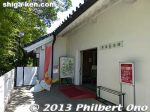
Entrance to Kaikoku Kinenkan museum.Jun 12, 2013
|
|
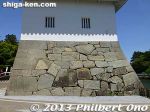
Jun 12, 2013
|
|

About the Ninomaru-Sawaguchi Tamon Yagura.Jun 12, 2013
|
|
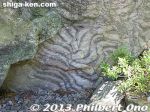
One of the large stones at the poetry monument has a duck carving.Jun 12, 2013
|
|

Naosuke's poem in modern Japanese. For the sake of the country, he had no regrets. A few months later, he was assassinated. Jun 12, 2013
|
|

While using a metaphor of Lake Biwa's waves crashing relentlessly against a rocky shore, the poem expresses Naosuke's brain-wracking efforts as Chief Minister in dealing with successive waves of difficult problems.Jun 12, 2013
|
|

Ii Naosuke's portrait painted by Kano Eigaku (狩野永岳). He wrote the poem above the painting offered to Seiryoji temple in Hikone. Jun 12, 2013
|
|
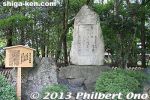
For New Year's in 1860, Naosuke had a formal portrait of himself painted by Kano Eigaku (狩野永岳) and wrote this poem above the portrait.Jun 12, 2013
|
|
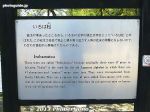
About the Iroha pine trees.Jun 12, 2013
|
|
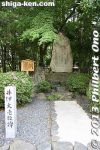
Lord Ii Naosuke Poetry Monument along the Iroha pine trees.Jun 12, 2013
|
|
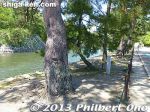
Some are Tosa (from Kochi Prefecture) pines whose roots do not protrude above ground.Jun 12, 2013
|
|

Iroha-matsu pine trees line the road to the castle.Jun 12, 2013
|
|
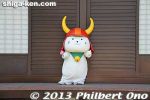
Hiko-nyan, the official mascot for Hikone Castle's 400th anniversary in 2007. He proven to be so popular that he has been retained as the city's official mascot. Basically a white cat with a horned samurai helmet. ひこにゃんOne of the most famous mascots in Japan.Jun 12, 2013
|
|
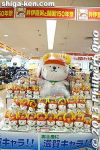
Hiko-nyan merchandise in HeiwadoJun 12, 2013
|
|
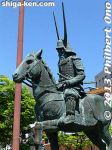
Naomasa planned to build a new castle, but died in 1602 from an old Sekigahara gunshot wound before construction began.Jun 12, 2013
|
|
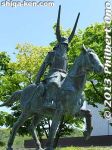
Sawayama Castle (佐和山城) came with the domain, but Naomasa did not like it, being outdated and the former castle of Ishida Mitsunari (石田 三成) who lost at Sekigahara.Jun 12, 2013
|
|
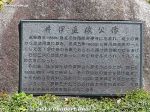
Ieyasu rewarded Naomasa with the strategic domain of Hikone (mainly Hikone, Maibara, Nagahama, Taga), making Naomasa the first Hikone daimyo (feudal lord 大名) in Omi Province (近江国).Jun 12, 2013
|
|
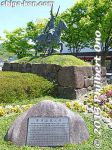
Statue of Lord Ii Naomasa (井伊 直政 1561-1602 ) in front of JR Hikone Station. One of the four great generals (徳川四天王) who helped Tokugawa Ieyasu win the Battle of Sekigahara (関ヶ原合戦) in 1600 to unify Japan and become shogun.Jun 12, 2013
|
|
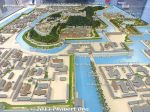
Scale model of Hikone Castle in the latter 18th and early 19th century.Jun 12, 2013
|
|
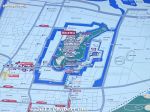
Map of Hikone. Hikone Castle is famous as being only one of five castles in Japan designated as a National Treasure. The tenshu castle tower is original, and you can enter it to get a good idea of what a real castle looked like.Jun 12, 2013
|
|
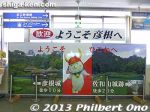
Welcome to Hikone, best known for Hikone Castle and mascot Hiko-nyan. At JR Hikone Station, this photo of official mascot Hikonyan greets you. MapJun 12, 2013
|
|

My 34-min. comprehensive English video about Hikone Castle, Genkyuen Garden, and autumn festivals. Jun 12, 2013
|
|
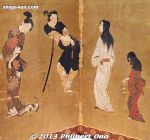
Notice the tobacco pipe and Western dog too. Artist is unknown, but likely belonged to the Kano school of Japanese painting (狩野派). Apr 18, 2013
|
|
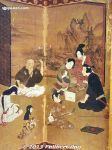
Hikone Byobu (彦根屏風) is a 17th-century National Treasure (国宝) folding screen. Painted on gold leaf, it shows a fashion-leading pleasure quarters scene in Kyoto (京都の遊里).Apr 18, 2013
|
|
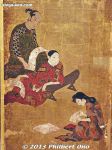
A variety of people, fashion, hairstyles, and objects from that era are depicted. See people playing the samisen, playing sugoroku Japanese backgammon, or writing a love letter.Apr 18, 2013
|
|

Hikone Byobu folding screen is a National Treasure and exhibited for a few weeks in April-May. Read more hereApr 17, 2013
|
|

"Hiko" refers to Hikone, and "nyan" is a baby word for cat. Hiko-nyan's appearance schedule is here.If it rains, Hiko-nyan appears at the Castle Museum. Hiko-nyan is a white cat wearing a red samurai helmet with horns, modeled after the one worn by Lord Ii Naomasa, the first lord of Hikone Castle.
Hiko-nyan also makes guest appearances at various events to promote Hikone. He has even traveled to Hawaii to appear in a Japan parade in Waikiki.Apr 01, 2013
|
|
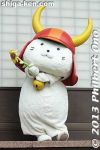
Hiko-nyan does not talk or even "meow." He speaks through a handler or translator. Basically, he (or it) just struts around and makes cute poses with or without a prop.Another legend says that as soon as the cat beckoned Naotaka into the temple, lightning struck the tree where he was standing. Thus, the cat saved his life.
This legendary cat connection gave birth to the idea behind Hiko-nyan. This same legend is also one theory for the origin of the ubiquitous beckoning cat you see at shops and restaurants in Japan. The beckoning cat can be called Hiko-nyan's cousin.Apr 01, 2013
|
|
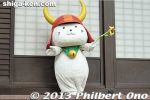
Hikone's official mascot Hiko-nyan appears three times daily for a 30-min. show: 10:30 am and 1:30 pm in front of the main castle tower (tenshu) and at 3:00 pm outside Hikone Castle Museum.According to legend, one day, Ii Naotaka, the third lord of Hikone Castle, was doing falconry in Tokyo and was near a temple when he saw this cat raising its paw. He was led inside the temple where he was able to rest inside. A major thunderstorm ensued, and the cat saved him from getting wet.Apr 01, 2013
|
|
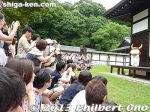
Hikone's super popular official mascot Hiko-nyan appears every day outside Hikone Castle Museum (photo) or in front of the main castle tower. A large crowd gathers each time.Hiko-nyan was the official mascot for Hikone Castle's 400th anniversary in 2007. He proven to be so popular that he has been retained as the city's official mascot.Apr 01, 2013
|
|

Hiroshige's woodblock print of Takamiya (65th post town on the Nakasendo) from his Kisokaido series. Suzuka mountains in the background.Apr 23, 2011
|
|
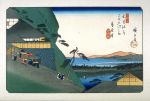
Hiroshige's woodblock print of Toriimoto (64th post town on the Nakasendo) from his Kisokaido series. Apr 23, 2011
|
|

Mar 27, 2010
|
|

Chrysanthemum looking like Hiko-nyan.Mar 27, 2010
|
|

Before or after the castle parade, you might as well see the chrysanthemum exhibit at Gokoku Shrine (護国神社), a shrine dedicated to Shiga's war dead.Mar 27, 2010
|
|

Mar 27, 2010
|
|

Mar 27, 2010
|
|

Mar 27, 2010
|
|

Mar 27, 2010
|
|

Mar 27, 2010
|
|

Mar 27, 2010
|
|

Mar 27, 2010
|
|

Mar 27, 2010
|
|

Mar 27, 2010
|
|

Shishimai lion danceMar 27, 2010
|
|

Mar 27, 2010
|
|

Mar 27, 2010
|
|

Mar 27, 2010
|
|

Mar 27, 2010
|
|

Dragon danceMar 27, 2010
|
|

Mar 27, 2010
|
|

Mar 27, 2010
|
|

Mar 27, 2010
|
|

Mar 27, 2010
|
|

Mar 27, 2010
|
|

Mar 27, 2010
|
|

Mar 27, 2010
|
|

Mar 27, 2010
|
|

Mar 27, 2010
|
|

Mar 27, 2010
|
|

Foreigners carry the shishimai lion heads, but they did not perform with it.Mar 27, 2010
|
|

Mar 27, 2010
|
|

Sarugaku is a centuries-old form of entertainment and a precursor to Noh and Kyogen.Mar 27, 2010
|
|

Sarugaku entertainers from the Omi Sarugaku Taga-za troupe. 猿楽Mar 27, 2010
|
|

Mar 27, 2010
|
|

Fireman's ladder acrobaticsMar 27, 2010
|
|

Fireman's acrobatics is a crowd pleaser.Mar 27, 2010
|
|

Mar 27, 2010
|
|

They hoist up the ladder for someone to climb up.Mar 27, 2010
|
|

Fireman's ladderMar 27, 2010
|
|

FiremenMar 27, 2010
|
|

Hikone Traditional Fireman Preservation GroupMar 27, 2010
|
|

Sitting like royalty, local politicians such as the mayor sit in a special stand on the right in front of the horse stable. The rest of us stand and watch like peasants.Mar 27, 2010
|
|

Mar 27, 2010
|
|

Hiko-nyan is Hikone's official mascot. A white cat wearing a samurai helmet modeled after Ii Naomasa.Mar 27, 2010
|
|

The matchlock guns make a huge bang.Mar 27, 2010
|
|

Hiko-nyanMar 27, 2010
|
|

They fire their matchlock guns.Mar 27, 2010
|
|

Mar 27, 2010
|
|

Mar 27, 2010
|
|

The Hikone Gun Battalion in formation for a firing demo.Mar 27, 2010
|
|

Mar 27, 2010
|
|

Ii NaotakaMar 27, 2010
|
|

Mar 27, 2010
|
|

Mar 27, 2010
|
|

Mar 27, 2010
|
|

Mar 27, 2010
|
|

Mar 27, 2010
|
|

Mar 27, 2010
|
|

Ii Naomasa (井伊直政) (1561-1602 ) was the first lord of Hikone from 1600. He was a general under Tokugawa Ieyasu whom he helped to win the Battle of Sekigahara in 1600. He was rewarded with the fief of Omi (now Shiga) and built Hikone Castle.Mar 27, 2010
|
|

Mar 27, 2010
|
|

Mar 27, 2010
|
|

Mar 27, 2010
|
|

Mar 27, 2010
|
|

Ii clan warriorsMar 27, 2010
|
|

Banners with the crest of the Ii clan.Mar 27, 2010
|
|

Ii Clan's "Red Devil" samurai vassals wearing their trademark red armor.Mar 27, 2010
|
|

Soldiers from the Ii clan.Mar 27, 2010
|
|

Mar 27, 2010
|
|

Katsugi veiled kimono worn by the nobility in the Muromachi Period.Mar 27, 2010
|
|

Mar 27, 2010
|
|

Shirabyoshi dancers from the Heian Period.Mar 27, 2010
|
|

Mar 27, 2010
|
|

Kamakura Period (1185–1333) women wearing veiled straw hats called ichime-gasa. 市女笠Mar 27, 2010
|
|

Mar 27, 2010
|
|

Dancers from Muromachi Period (1337-1573)Mar 27, 2010
|
|

Mar 27, 2010
|
|

Shrine maidens from IzumoMar 27, 2010
|
|

Mar 27, 2010
|
|

Samurai wivesMar 27, 2010
|
|

Mar 27, 2010
|
|

A daimyoMar 27, 2010
|
|

Mar 27, 2010
|
|

Chief retainer who started the construction of Hikone Castle upon the wishes of Ii Naomasa. 家老の木俣守勝Mar 27, 2010
|
|

Mar 27, 2010
|
|

Mar 27, 2010
|
|

Mar 27, 2010
|
|

Samurai laborers carrying luggage for a traveling daimyo.Mar 27, 2010
|
|

Mar 27, 2010
|
|

Mar 27, 2010
|
|

Mar 27, 2010
|
|

A few foreigners too.Mar 27, 2010
|
|

Heian Period (794-1185) women wearing veiled straw hats called ichime-gasa. 市女笠Mar 27, 2010
|
|

Next are groups wearing period costumes. They are junior high schoolers.Mar 27, 2010
|
|

Ii Naosuke (井伊 直弼) (1815-1860) as the Tokugawa shogunate's Chief Minister (Tairo) who favored and concluded commercial treaties with the Western powers and thus broke Japan's isolation from the world.Mar 27, 2010
|
|

Ii Naosuke is portrayed by an actor.Mar 27, 2010
|
|

Little Edo Hikone Castle Festival ParadeMar 27, 2010
|
|

Ii Naosuke processionMar 27, 2010
|
|

Hikone Gun BattalionMar 27, 2010
|
|

Hikone Gun Battalion whose members are licensed to fire matchlock guns.Mar 27, 2010
|
|

Hikone Gun Battalion dressed like Ii Clan samurai with their trademark red armor nicknamed "Red Devils."Mar 27, 2010
|
|

Mar 27, 2010
|
|

Asahinomori Elementary School in Hikone.Mar 27, 2010
|
|

Mar 27, 2010
|
|

Kawase Junior and Senior High School band.Mar 27, 2010
|
|

Miss Hikone CastleMar 27, 2010
|
|

Miss Hikone CastleMar 27, 2010
|
|

Tourist Site Clean CampaignMar 27, 2010
|
|

Flags from sister cities.Mar 27, 2010
|
|

Miss Plum Blossom from Mito, Ibaraki Pref. Mito's connection with Hikone lies in the radical samurai who assassinated Ii Naosuke near Edo Castle.Mar 27, 2010
|
|

Castle parade route to Hikone Castle.Mar 27, 2010
|
|

Dream Ambassador from Takamatsu, Kagawa Pref.Mar 27, 2010
|
|

Military bandMar 27, 2010
|
|

Start of the Hikone Castle Parade on Nov. 3. Boy Scouts help out by carrying signs.Mar 27, 2010
|
|

These photos were taken on Nov. 3, 2009.Mar 27, 2010
|
|

The parade has children and adults dressed in historical costumes, especially the red samurai armor which was the trademark of the Ii clan. Even a modern samurai needs a cell phone. Mar 27, 2010
|
|

The main highlight of the festival is the Hikone Castle Festival Parade held in the afternoon of Nov. 3 (national holiday called Culture Day).Mar 27, 2010
|
|

Nicknamed Little Edo (Koedo), the castle town of Hikone holds the annual Little Edo Hikone Castle Festival Parade on Nov. 3 from 1 pm to 3 pm.Very elaborate costume parade of mainly kids dressed as samurai and Edo-Period ladies. Highlights include the Hikone Gun Battalion giving a matchlock gun demo (in front of Horse Stable), Ii Naosuke played by an actor on horseback, fireman acrobatics, and Sarugaku dancers. The parade route starts from Joto Elementary School and proceeds along the road to the castle and passes in front of the Umaya Horse Stable. Short walk from JR Hikone Station. Parade route map:
http://www.hikoneshi.com/jp/event/articles/c/parade
Photo: Statue of Lord Ii Naomasa in front of Hikone Station. Mar 27, 2010
|
|

English information sign for Taikomon Gate.Mar 27, 2010
|
|
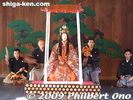
Noh play on the Noh stage inside Hikone Castle Museum.Mar 27, 2010
|
|
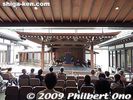
Another museum centerpiece is this Edo-Period Noh stage, the only original palace structure. Noh is performed in spring and autumn.Mar 27, 2010
|
|

Matchlock gunMar 27, 2010
|
|

Letter written by Ii Naosuke is also displayed in the Hikone Castle Museum.Mar 27, 2010
|
|

About the Ii clan's samurai armor. It was all red.Mar 27, 2010
|
|
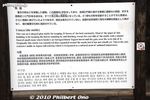
About the Umaya Horse Stable in English, Korean, and Chinese.Mar 27, 2010
|
|

Inside Hikone Castle Museum are samurai armor exhibits.Mar 27, 2010
|
|

Ii clan samurai armor and helmet. Remember this helmet because it also appears on Hikone's official mascot Hiko-nyan (photos below).Mar 27, 2010
|
|

Photography is allowed only in this room of the museum.Mar 27, 2010
|
|

Cross section of Hikone Castle.Mar 27, 2010
|
|

Inside the Kaikoku Kinenkan museum in 2007, the castle's 400th anniversary.Mar 27, 2010
|
|

Where Hiko-nyan's helmet design came from.Mar 27, 2010
|
|

Mar 26, 2010
|
|

Tabi-maru. a traveler character from Kusatsu, Shiga. Kusatsu was a crossroads on the old Tokaido and Nakasendo Roads where many travelers lodged. "Tabi" means "travel." たび丸 (滋賀 草津市)Mar 26, 2010
|
|

Mar 26, 2010
|
|

Mar 26, 2010
|
|

Mar 26, 2010
|
|

Mar 26, 2010
|
|

Mar 26, 2010
|
|

Mar 26, 2010
|
|

Saba-tora Nana-chan is a cat with stripes from mackerel (saba). See the fish in her pouch. Promote Obama in Fukui Pref. さばトラななちゃん (福井 小浜市)Mar 26, 2010
|
|

Mar 26, 2010
|
|

Mar 26, 2010
|
|

Mar 26, 2010
|
|

Mar 26, 2010
|
|

Mar 26, 2010
|
|

Mar 26, 2010
|
|

Mar 26, 2010
|
|

Mar 26, 2010
|
|

Mar 26, 2010
|
|

Vivace-kun is a beaver promoting Viva City shopping mall in Hikone, Shiga. ビバッチェくん (滋賀 彦根市)Mar 26, 2010
|
|

Ogoton from Ogoto Onsen, OtsuMar 26, 2010
|
|

Mar 26, 2010
|
|

Mar 26, 2010
|
|

Mar 26, 2010
|
|

Mar 26, 2010
|
|

Mar 26, 2010
|
|

Mar 26, 2010
|
|

Mar 26, 2010
|
|

The Azai sisters. On the left is Chacha-hime, based on the eldest daughter Chacha (later Lady Yodo-dono) of Lord Azai Nagamasa and Oichi (sister of Oda Nobunaga) who lived in Odani Castle in Kohoku-cho. Middle is Hatsu, and Go on the right. 茶々姫Mar 26, 2010
|
|

Mimi-chan from Minami-ku, Sakai, Osaka Pref. A female flower promoting Minami-ku. Notice the bee on her forehead. みみちゃん (大阪 堺市南区)Mar 26, 2010
|
|

Mar 26, 2010
|
|

Mar 26, 2010
|
|

Mar 26, 2010
|
|

Mar 26, 2010
|
|

Mar 26, 2010
|
|

Mar 26, 2010
|
|

Dotaku-kun from Yasu, Shiga. Modeled after Japan's largest ancient bronze bell discovered in Yasu. ドウタクくん (滋賀 野洲市)Mar 26, 2010
|
|

Mar 26, 2010
|
|

Mar 26, 2010
|
|

Mar 26, 2010
|
|

Takumi Ponzan, a tanuki potter mascot from Shigaraki, Koka, ShigaMar 26, 2010
|
|

Mar 26, 2010
|
|

Mar 26, 2010
|
|

Mar 26, 2010
|
|

Mar 26, 2010
|
|

Adjacent to the Castle Road is Yonbancho Square shopping mall which was also crawling with mascot characters. 四番町スクエアMar 26, 2010
|
|

Mar 26, 2010
|
|

Inflatable sumo wrestlerMar 26, 2010
|
|

Mar 26, 2010
|
|

Mar 26, 2010
|
|

Mar 26, 2010
|
|

Mar 26, 2010
|
|

Mar 26, 2010
|
|

Mar 26, 2010
|
|

Mar 26, 2010
|
|

Hatsu AzaiMar 26, 2010
|
|

Mar 26, 2010
|
|

Mar 26, 2010
|
|

Mar 26, 2010
|
|

Mar 26, 2010
|
|

Mar 26, 2010
|
|

Mar 26, 2010
|
|

Mar 26, 2010
|
|

Hiko-nyan is the most popular character, but he was least seen and not available to the public. No one could get close.Mar 26, 2010
|
|

Mar 26, 2010
|
|

Hiko-nyan arrives on a cart pulled by bicycle. He didn't stop and kept going.Mar 26, 2010
|
|

Mar 26, 2010
|
|

Mar 26, 2010
|
|

Mar 26, 2010
|
|

Mar 26, 2010
|
|

Mar 26, 2010
|
|

Mar 26, 2010
|
|

Mar 26, 2010
|
|

Mar 26, 2010
|
|

Mar 26, 2010
|
|

A water drop and water faucet pose together.Mar 26, 2010
|
|

Mar 26, 2010
|
|

Official mascots of Maibara, Shiga Prefecture. A pair of fireflies.Mar 26, 2010
|
|

Mama firefly from MaibaraMar 26, 2010
|
|

Mar 26, 2010
|
|

Mar 26, 2010
|
|

Mar 26, 2010
|
|

Baby godzillaMar 26, 2010
|
|

Mar 26, 2010
|
|

Mar 26, 2010
|
|

Mar 26, 2010
|
|

Daughter Sagawa from Moriyama.Mar 26, 2010
|
|

Sagawa family of mascots from Sagawa Art Museum in Moriyama, Shiga.Mar 26, 2010
|
|

Mar 26, 2010
|
|

Mar 26, 2010
|
|

Mar 26, 2010
|
|

Mar 26, 2010
|
|
| 1077 files on 5 page(s) |
2 |  |
 |
|